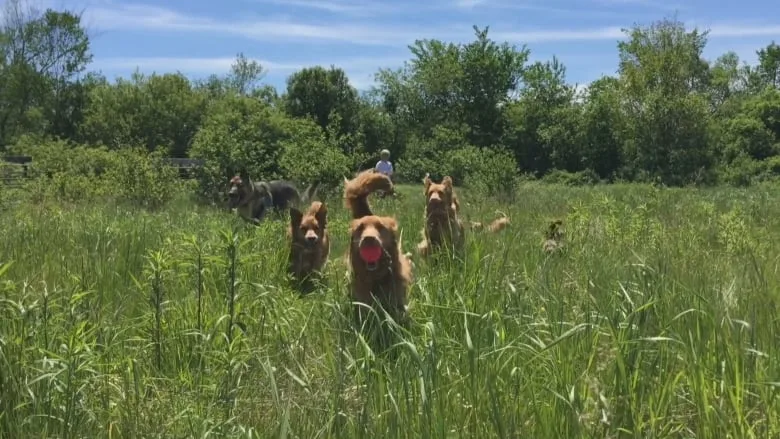
Pet owners beware: Possibly fatal tapeworm found in Ontario
Research from the University of Guelph has found that a quarter of foxes and coyotes in southern Ontario have a tapeworm that can be fatal to dogs and their owners.
Nearly one in four coyotes and foxes in the area from Windsor to Ottawa tested positive for the Echinococcus multilocularis tapeworm, which has only been found in Western Canada so far.
Prof. Andrew Peregrine, the report's lead researcher at the Ontario Veterinary College at the University of Guelph, said the findings suggest the tapeworm is now well established and has been present even longer than indicated by the study.
Over two winters, the research team collected the carcasses of 460 foxes and coyotes, which belong to the wild canid family, and examined their intestines.
They found 23 per cent of them tested positive for E. multilocularis. The first case was identified in 2012 in five dogs, as well as three other species in southern Ontario.

Dogs who eat live rodents or coyote and fox feces infected with the E. multilocularis parasite can develop a severe infection called alveolar echinococcosis. Photo: Evan Mitsui/CBC.
DON'T MISS: Our country is warming two times faster than the rest of the planet. The Weather Network and Canada's leading experts on climate bring you 2xFaster, an exclusive series premiering Tuesday, April 16.
"In fact, when we first showed the data to those we were working with in Sweden, they said two things: You've had it a lot longer than you think, and it's most likely come in from the U.S.," Peregrine said.
The E. multilocularis parasite is spread by coyotes and foxes that eat infected rodents, such as field mice, the report found.
For reasons that are not yet known, the wild animals don't become sick, but dogs that eat coyote or fox feces containing parasite eggs — or dogs that hunt and eat infected rodents — can develop a severe infection called alveolar echinococcosis, or AE.
Humans can become infected immediately if these eggs find a way into their system. Pet owners are likely to acquire them from their dogs, not from direct contact with the poop of foxes and coyotes, Peregrine said.
It's when owners let their pets sleep in their beds that they're more likely to get the microscopic tapeworm: If a dog's lower end is covered with the parasites, they can be transferred to the dog owner's bed and ingested that way.

Off-leash dogs are more likely to ingest the parasite. Photo: Marina von Stackelberg/CBC.
The parasite goes largely undetected and can produce no signs or symptoms in dogs or humans. Both can carry the infection for years, but, over time, it aggressively attacks the liver, becoming potentially fatal.
For dog owners, the infection can cause devastating loss.
Megan MacLusky often let her dog Bauer off-leash during their walks in the fields and woods around Guelph, Ont., where she lives, and the two travelled to Alberta in 2012.
Two years later, Bauer developed a large mass on his side, which turned out to be an enlarged liver and a cyst.
After a series of tests and vet visits, his veterinarian concluded that the liver was enlarged due to the AE infection, and the cyst contained the parasites.
MacLusky put Bauer on antiparasitic medication. When that didn't work, he underwent surgery, but the cyst could not be fully removed.
"Bauer actually went almost back to normal for about a year, but, eventually, more cysts formed," she said.
MacLusky said another surgery was performed in early 2016 to try to remove the cysts, but they had enveloped Bauer's gallbladder and formed on other organs.

'Bauer must have ingested coyote feces at some point, but he would rummage in things so often that I can't be sure when this happened,' said MacLusky of her dog, seen after surgery to remove cysts caused by the parasite. Photo: Megan MacLusky.
Shortly after the operation, she made the difficult decision to put him down because he was in too much pain.
PREVENTATIVE TREATMENT
Peregrine says the parasite is present in both rural and urban areas, and it's important for dog owners to talk to their veterinarians about their pets' exercise habits.
"The vets now know where this parasite is, and where in the province the greatest risk is," he said.
"If your dog is known to eat rodents, or hunt, there is a drug [it can take] to stop it from developing intestinal infections, so that eliminates any concerns about infections in people in the household."
But not every dog needs the treatment. If your dog never goes off-leash, either in an urban or rural area, it's unlikely to be eating rodents. The risk is higher for dogs who are often off-leash, Peregrine said.
Alessandro Massolo, an adjunct professor of wildlife health ecology at the University of Calgary, has also researched the E. multilocularis tapeworm.
He says the extent of the threat in Ontario is still largely unknown, but it should be taken seriously, especially if it turns out to be a European strain, which is more dangerous than the North American one.
While the North American strain has been detected in Western Canada, the study of infected fox and coyote carcasses in southern Ontario did not establish which strain was present.
"If the European strain [is] circulating in our wildlife, then things change completely, because the European strain is known to be very virulent in people," Massolo said.
If the European is present in Ontario, it's not yet known how it arrived.
Nor can the geographic range of the parasite be fully understood until a proper survey is done, but such surveys take a long time and tend to be costly, he said.
One thing the Guelph study does show is that something has changed from an ecological standpoint, said Massolo, and the fact that the parasite is spreading is increasing the risk to both people and animals.
"In any case, it's a type of infection you don't want."
Written by Celeste Decaire/CBC News
Source: CBC









